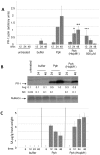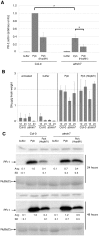The Pseudomonas syringae pv. tomato type III effector HopM1 suppresses Arabidopsis defenses independent of suppressing salicylic acid signaling and of targeting AtMIN7
- PMID: 24324742
- PMCID: PMC3855835
- DOI: 10.1371/journal.pone.0082032
The Pseudomonas syringae pv. tomato type III effector HopM1 suppresses Arabidopsis defenses independent of suppressing salicylic acid signaling and of targeting AtMIN7
Abstract
Pseudomonas syringae pv tomato strain DC3000 (Pto) delivers several effector proteins promoting virulence, including HopM1, into plant cells via type III secretion. HopM1 contributes to full virulence of Pto by inducing degradation of Arabidopsis proteins, including AtMIN7, an ADP ribosylation factor-guanine nucleotide exchange factor. Pseudomonas syringae pv phaseolicola strain NPS3121 (Pph) lacks a functional HopM1 and elicits robust defenses in Arabidopsis thaliana, including accumulation of pathogenesis related 1 (PR-1) protein and deposition of callose-containing cell wall fortifications. We have examined the effects of heterologously expressed HopM1Pto on Pph-induced defenses. HopM1 suppresses Pph-induced PR-1 expression, a widely used marker for salicylic acid (SA) signaling and systemic acquired resistance. Surprisingly, HopM1 reduces PR-1 expression without affecting SA accumulation and also suppresses the low levels of PR-1 expression apparent in SA-signaling deficient plants. Further, HopM1 enhances the growth of Pto in SA-signaling deficient plants. AtMIN7 contributes to Pph-induced PR-1 expression. However, HopM1 fails to degrade AtMIN7 during Pph infection and suppresses Pph-induced PR-1 expression and callose deposition in wild-type and atmin7 plants. We also show that the HopM1-mediated suppression of PR-1 expression is not observed in plants lacking the TGA transcription factor, TGA3. Our data indicate that HopM1 promotes bacterial virulence independent of suppressing SA-signaling and links TGA3, AtMIN7, and other HopM1 targets to pathways distinct from the canonical SA-signaling pathway contributing to PR-1 expression and callose deposition. Thus, efforts to understand this key effector must consider multiple targets and unexpected outputs of its action.
Conflict of interest statement
Figures







References
-
- Chisholm ST, Coaker G, Day B, Staskawicz BJ (2006) Host-microbe interactions: shaping the evolution of the plant immune response. Cell 124: 803–814. - PubMed
-
- Mackey D, McFall AJ (2006) MAMPs and MIMPs: proposed classifications for inducers of innate immunity. Molecular microbiology 61: 1365–1371. - PubMed
-
- Jones JD, Dangl JL (2006) The plant immune system. Nature 444: 323–329. - PubMed
-
- Glazebrook J (2005) Contrasting mechanisms of defense against biotrophic and necrotrophic pathogens. Annu Rev Phytopathol 43: 205–227. - PubMed
Publication types
MeSH terms
Substances
LinkOut - more resources
Full Text Sources
Other Literature Sources
Molecular Biology Databases
Research Materials

